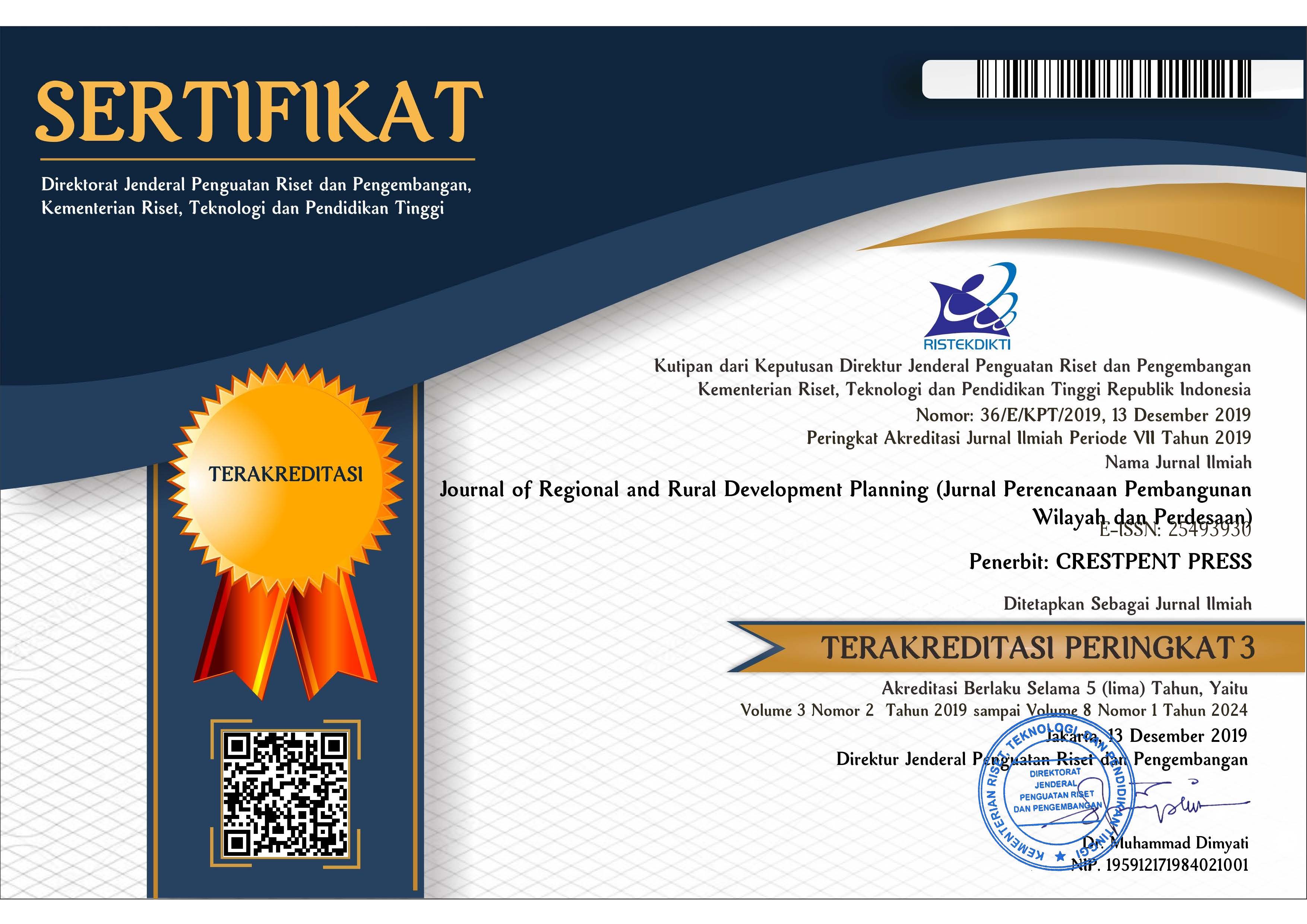Keterkaitan Efisiensi Kredit Usaha Rakyat (KUR) dengan Topografi Wilayah di Kabupaten Pati, Provinsi Jawa Tengah
Abstract
Exogenous factors such as topography of the region are often overlooked in determining the pattern of economic activity. In fact, the geographical surface contributes to the spatial distribution of varied economic activities. The purpose of this study was to see the linkage between the efficiency of the disbursement of People’s Business Credit (KUR) program and the topography of the region in Pati Regency-Central Java. The research method is descriptive qualitative by overlaying the efficiency level of 35 KUR channeling banks with polygon maps of each subdistrict in Pati regency. Data on the efficiency level of unit banks are secondary data of each bank unit which has been calculated with Data Envelopment Analysis (DEA) application. Is it dicovered that unit banks are very inefficient at topographies bordered with arid limestone mountains or along rivers that often overflows. As a result, economic activity is not optimal and the disbursement of KUR is not efficient at the area. On the contrary, at topographies in the lowlands, the trade, agriculture, and fisheries sectors are advanced, population is large, economic activities are fast, thus encourage efficient credit disbursement.
References
Allen, T., & Arkolakis, C. (2014). Trade and the Topography of the Spatial Economy. The Quartely Journal of Economics, 129 (3),1085-1140.
Anggraini, D., & Nasution, S. H. (2013). Peranan Kredit Usaha Rakyat bagi pengembangan UMKM di Kota Medan (Studi kasus Bank BRI). Jurnal Ekonomi dan Keuangan, 1 (3).
Awunyo-Vitor, D & Abankwah, V. (2012). Substitutes or Complements? ; Formal and Informal Credit Demand by Maize Farmers in Ashanti and Brong Ahafo Regions of Ghana.
International Journal of Agriculture and Forestry, 2(3), 105-112.
Balagobei, S. (2016). Efficiency of Micro Finance Institutions and Financial Sustainability in Jaffna District. Journal of Economics and Sustainable Development, 7(24), 7.
Banerjee, S. B., & Jackson, L. (2017). Microfinance and the Business of Poverty Reduction: Critical Perspectives from Rural Bangladesh. Human Relations, 70 (1), 62-91.
BPS. (2015). BPS Kabupaten Pati. https://patikab.bps.go.id/
Burger, A., Мурманн, Ю., Бургер, А., & Moormann, J. (2008). Productivity in banks: myths & truths of the cost income ratio. Bank and Bank Systems, 3 (4).
Chandio, A. A., Jiang, Y., Wei, F., Rehman, A., & Liu, D. (2017). Famers’ access to credit: Does collateral matter or cash flow matter?—Evidence from Sindh, Pakistan. Cogent Economics & Finance, 5(1), 1-13.
David, A., & Rose, B. (2017). Challenges Facing Small Scale Entrepreneuresin Accessing Loan from Banks at Ngongongare, Meru District, Arusha Region in Tanzania. IOSR Journal of Business and Management, 19(03), 103–113.
Demirgüç-Kunt, A., & Klapper, L. F. (2012). Financial inclusion in Africa: an overview. https://elibrary.worldbank.org/doi/pdf/10.1596/1813-9450-6088
Dilts, D. M., Zell, A., & Orwoll, E. (2015). A Novel Approach to Measuring Efficiency of Scientific Research Projects: Data Envelopment Analysis: Novel Approach to Measuring Efficiency of Scientific Research Projects. Clinical and Translational Science, 8(5), 495–501.
Duy, V. Q., D’Haese, L., Lemba, J., Hau, L. L., & D’Haese, M. (2012). Determinants of Household Access to Formal Credit in the Rural Areas of the Mekong Delta, Vietnam. African and Asian Studies, 11(3), 261–287.
Emekter, R., Tu, Y., Jirasakuldech, B., & Lu, M. (2015). Evaluating credit risk and loan performance in online Peer-to-Peer (P2P) lending. Applied Economics, 47(1), 54–70.
Farida, F., Osman, I. R., Lim, A. K., & Wahyuni, N. (2018). Efficiency of Formal Microfinance in Indonesia: Using Data Envelopment Analysis Application. Iranian Economics Review, 22(3), 787–810.
Farida, F., Siregar, H., & Nuryartono, N. (2016). An Impact Estimator Using Propensity Score Matching: People’s Business Credit Program to Micro Entrepreneurs in Indonesia. Iranian Economic Review, 20(4), 599–615.
Gama, A. P. M., & Duarte, F. D. (2015). Collateral and relationship lending in loan pricing: Evidence from UK SMEs. Wseas Transactions on Businesss and Economics, 12 (15). 21-35.
Khan MA and Rahaman MA. 2007. Impact of Microfinance on Living Standards, Empowerment and Poverty Alleviation of Poor People: Case Study on Microfinance in the Chittagong District of Bangladesh. Thesis. Umea School of Business (USBE). Bangladesh.
Kost A, Laderach P, Fisher M, Cook S, Gomez L. (2012). Improving Index-Based Drought Insurance in Varying Topography: Evaluating Basis Risk Based on Perceptions of Nicaraguan Hillside Farmers. Plos ONE 7(12),1-11.
Mayer, H., Habersetzer, A., & Meili, R. (2016). Rural-Urban Linkages and Sustainable Regional Development: The Role of Entrepreneurs in Linking Peripheries and Centers. Sustainability, 8 (8), 745-758.
Parasuraman, A. (2010). Service productivity, quality and innovation: Implications for service‐design practice and research. International Journal of Quality and Service Sciences, 2(3), 277–286.
Sujarweni, V. W., & Utami, L.R. (2015). Analisis Dampak Pembiayaan Dana Bergulir KUR (Kredit Usaha Rakyat) Terhadap Kinerja UMKM. Jurnal Bisnis dan Ekonomi, Vol. 22 (1), 11-24
Thanassoulis, E., & Silva, M. C. A. (2018). Measuring Efficiency Through Data Envelopment Analysis. Impact, 2018(1), 37–41.
Zhang, Q. (2017). Does Microfinance Reduce Poverty? Some International evidence. The B. E. Journal of Macroeconomics, 17 (2).
Copyright (c) 2019 Journal of Regional and Rural Development Planning

This work is licensed under a Creative Commons Attribution-ShareAlike 4.0 International License.




.png)














